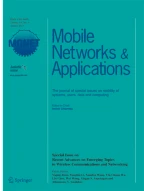Abstract
It has been shown recently that using Mobile Agents (MAs) in wireless sensor networks (WSNs) can help to achieve the flexibility of over-the-air software deployment on demand. In MA-based WSNs, it is crucial to find out an optimal itinerary for an MA to perform data collection from multiple distributed sensors. However, using a single MA brings up the shortcomings such as large latency, inefficient route, and unbalanced resource (e.g. energy) consumption. Then a novel genetic algorithm based multi-agent itinerary planning (GA-MIP) scheme is proposed to address these drawbacks. The extensive simulation experiments show that GA-MIP performs better than the prior single agent algorithms in terms of the product of delay and energy consumption.
Similar content being viewed by others
Notes
Even if they do not have the same length segment currently, Source-Grouping-Codes are changed by the mutation process at each iteration, to be detailed later. Thus, they will have the same length segment at some later iteration.
OPNET, http://www.opnet.com/.
References
Romer K, Mattern F (2004) The design space of wireless sensor networks. IEEE Wirel Commun 11(6):14–21
Tong L, Zhao Q, Adireddy S (2003) Sensor networks with mobile agents. In: Proceedings of the 2003 IEEE international conference on military communications (MILCOM 2003). Boston, Massachusetts
Beigl M, Krohn A, Zimmer T, Decker C, Robinson P (2003) AwareCon: situation aware context communication. In: Proceedings of the 5th IEEE international conference on ubiquitous computing (UbiComp 2003). Seattle, Washington, pp 132–139
Chen M, Gonzalez S, Leung V (2007) Applications and design issues for mobile agents in wireless sensor networks. Wirel Commun IEEE 14(6):20–26
Chen M, Kwon T, Yuan Y, Leung VC (2006) Mobile agent based wireless sensor networks. Journal of Computers 1(1):14–21
Chen M, Kwon T, Yuan Y, Choi Y, Leung VCM (2007) Mobile agent-based directed diffusion in wireless sensor networks. EURASIP J Appl Signal Process 2007(1):219–219
Qi H, Wang F (2001) Optimal itinerary analysis for mobile agents in ad hoc wireless sensor networks. In: Proceedings of the IEEE 2001 international conference on communications (ICC 2001). Helsinki, Finland
Chen M, Leung V, Mao S, Kwon T, Li M (2009) Energy-efficient itinerary planning for mobile agents in wireless sensor networks. In: Proceedings of the IEEE 2009 international conference on communications (ICC 2009). Bresden, Germany, pp 1–5
Wu Q, Rao NSV, Barhen J, Iyengar SS, Vaishnavi VK, Qi H, Chakrabarty K, Member S, Member S (2004) On computing mobile agent routes for data fusion in distributed sensor networks. IEEE Trans Knowl Data Eng 16:740–753
Chen M, Gonzlez S, Zhang Y, Leung VC (2009) Multi-agent itinerary planning for sensor networks. In: Proceedings of the IEEE 2009 international conference on heterogeneous networking for quality, reliability, security and robustness (QShine 2009). Las Palmas de Gran Canaria, Spain
Szewczyk R, Mainwaring A, Polastre J, Anderson J, Culler D (2004) An analysis of a large scale habitat monitoring application. In: Proceedings of the ACM 2004 2nd international conference on embedded networked sensor systems (SenSys 2004). Boston, MA, pp 214–226
Mitchell M (1998) An introduction to genetic algorithms. MIT
Poli R, Langdon WB (1998) Schema theory for genetic programming with One-Point crossover and point mutation. Evol Comput 6(3):231–252
Jong KAD, Spears WM (1992) A formal analysis of the role of multi-point crossover in genetic algorithms. Ann Math Artif Intell 5(1):1–26
Zhao Y, Wang Q, Jiang D, Wu W, Hao L, Wang K (2008) An agent-based routing protocol with mobile sink for wsn in coal mine. In: Proceedings of the 3rd international conference on pervasive computing and applications (ICPCA 2008). Alexandria, Egypt
Cheng L, Chen C, Ma J, Shu L, Chen H, Yang LT (2009) Residual time aware forwarding for randomly duty-cycled wireless sensor networks. In: Proceedings of the 7th IEEE/IFIP international conference on embedded and ubiqutious computing (EUC 2009). Vancouver, Canada
Acknowledgements
This work was supported by the IT R&D program of MKE/KEIT. [KI001862, MKE/KEIT], and was partially supported by Grant-in-Aid for Scientific Research (S)(21220002) of the Ministry of Education, Culture, Sports, Science and Technology, Japan.
Author information
Authors and Affiliations
Corresponding author
Rights and permissions
About this article
Cite this article
Cai, W., Chen, M., Hara, T. et al. A Genetic Algorithm Approach to Multi-Agent Itinerary Planning in Wireless Sensor Networks. Mobile Netw Appl 16, 782–793 (2011). https://doi.org/10.1007/s11036-010-0269-z
Published:
Issue Date:
DOI: https://doi.org/10.1007/s11036-010-0269-z
